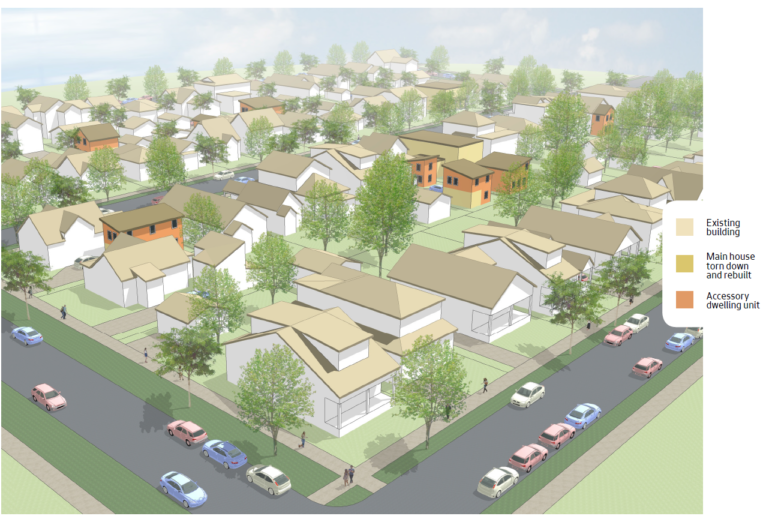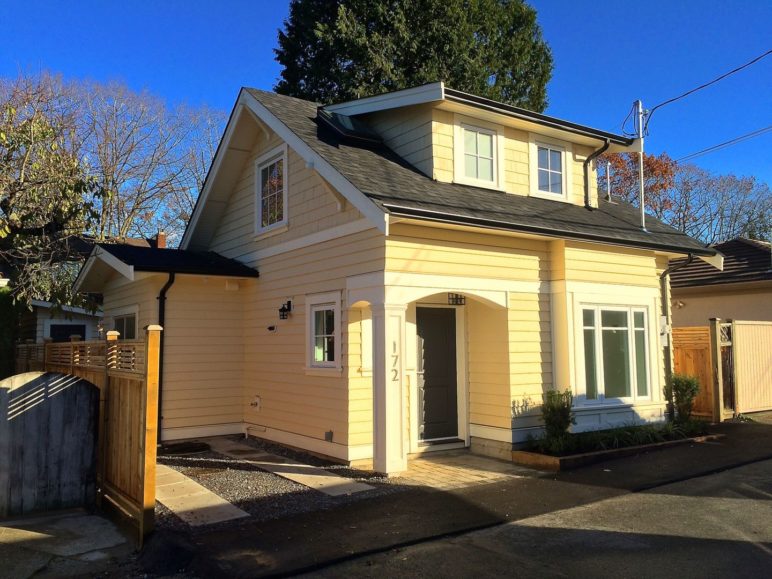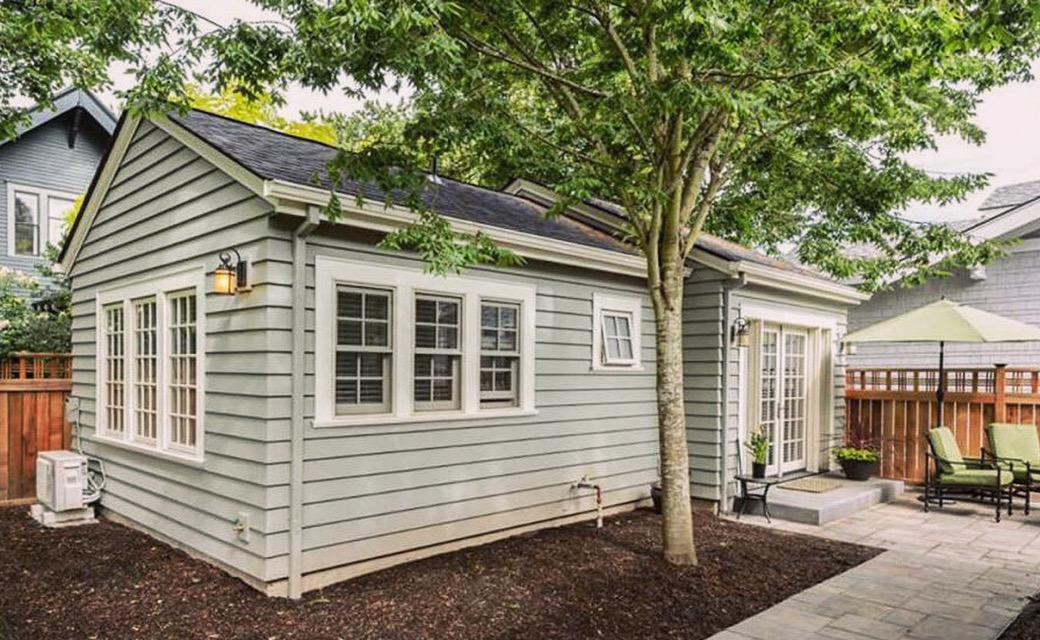How long does it take for a major US city with home prices off the charts to fix ill-conceived rules that hold back the construction of granny flats and backyard cottages?
In Seattle’s case, four long years. The good news, though, is that Seattle is poised to enact policy for these accessory dwellings that sets the gold standard for Cascadia and beyond.
In 2015, Seattle unveiled a housing plan that recommended reforms to make it easier for homeowners to build accessory dwelling units (ADUs). Mired for three of the four subsequent years in appeals filed by anti-housing activists, the proposal finally cleared its last legal hurdle earlier this month, with city council approval expected in June. City officials project that over ten years the rule changes would boost the construction of ADU homes to 4,300, a gain of 2,300 homes over the status quo.
The new legislation—mostly matching what the city’s plan called for four years ago—undoes the biggest code barriers to mother-in-law units, daylight basement suites, garage apartments, and backyard cottages: it would eliminate requirements for parking and for the owner to live on site, relax restrictions on size, height, and site layout, and allow two ADUs per lot, not just one—a first for any Washington city.
It also throws in a radical new provision: as a dual strategy to end the proliferation of McMansions and incentivize ADUs, the legislation reduces the allowed size of new houses. But ADUs don’t count against the size limit, giving builders the option to make up for the capped house size by adding in-law apartments or separate cottages. The result: smaller homes, and more of them per lot—a win-win for affordability.
The only potential serious flaw with the legislation is a mandate that a property be under single ownership for a year before a second ADU is allowed (the latest draft struck the measure but the debate isn’t over). It’s meant to assuage fears of builders snapping up older, inexpensive houses to demolish and replace with a new house and two ADUs. But the city’s own analysis predicted fewer teardowns under the proposed rules.
An ownership requirement is a solution looking for a problem that will leave the city with fewer ADU homes. By rejecting it, Seattle city councilmembers can turn a great reform package into a stellar one, and they will then have the opportunity to pass one of the most progressive ADU policies in North America.
Read on for a summary of the timeline, a review of what’s in the legislation, and a closer look at the proposed house size limit and ownership rule, including a comparison to Vancouver, BC.
The sorry, dragged-out timeline
It’s hard to overstate the absurdity of how long it has taken to enact reforms to ease this gentlest form of homebuilding in the fastest growing major US city of the decade. Applying Seattle’s estimates, the three years of legal delays caused by a tiny minority of wealthy homeowners cost the city about 700 ADU homes. That may not sound like much, but tell that to the 700 families denied the opportunity to live in Seattle.
Here’s how it went down:
- July 2015: Seattle’s Housing Affordability and Livability Agenda (HALA) recommends:
– Eliminating parking quotas
– Removing the requirement for the owner to live on site
– Allowing a single lot to have two ADUs
– Relaxing various development standards
- December 2015: Councilmember Mike O’Brien introduces legislation to make these changes (except it loosens, but does not eliminate, the city’s ownership requirement).
- May 2016: City planners issue a determination that the proposed changes would have “minimal impacts.”
- June 2016: The Queen Anne Community Council appeals the city’s determination, as allowed under the rules of the State Environmental Policy Act.
- December 2016: The hearing examiner upholds the appeal, directing city planners to conduct an extensive analysis called an Environment Impact Statement (EIS).
- October 2018: The city releases the final draft of its EIS, which affirms the city’s May 2016 determination and debunks the appellants’ claims.
- October 2018: The Queen Anne Community Council appeals the EIS.
- May 2019: The hearing examiner dismisses the appeal.
- May 2019: Three and a half years after he tried the first time, Mike O’Brien introduces slightly revised ADU legislation, anticipating a city council vote in late June.

What Seattle’s proposed ADU legislation would do
Seattle’s new ADU legislation mimics the 2015 proposal in all the important ways except two: it adds brand new house size limit, and it may introduce a requirement for year-long ownership—more on both below. For details on the proposed changes, check out my previous article. To summarize, the current proposal would:
- Up the per lot allowance from one ADU to two, with the option of one attached ADU (AADU) that’s part of the main house and one detached ADU (DADU) that’s a separate structure, or two AADUs.
- Eliminate the requirement to provide off-street parking spaces.
- Increase the maximum DADU size from 800 to 1,000 square feet.
- Reduce the minimum lot size for DADUs from 4,000 to 3,200 square feet.
- Raise allowed DADU height one to three feet depending on lot width or green building features.
- Increase rear yard lot coverage limit from 40 to 60 percent for DADUs no taller than 15 feet.
- Allow ADU entries on any façade as long as it’s 10 feet from property lines.
- Raise the limit on unrelated occupants on a lot from eight to twelve.
And what the proposal wouldn’t do
Seattle’s proposed reforms don’t address fees and financing, which can be formidable challenges for homeowners attempting their own ADU projects. Fortunately, Seattle doesn’t charge impact fees, though the county’s sewer hookup charge can be a heavy lift for low-budget ADUs. Proponents in several US cities are experimenting with ways to help owners finance ADUs, models that Seattle can consider to reinforce its code reforms (see endnotes).
The proposed legislation also doesn’t impose any new restrictions on using ADUs for short-term rentals (STRs). In 2017 Seattle prohibited people from having more than one STR in addition to their primary residence, so that law already prevents two ADU STRs on one lot. First of all, there’s no justification for an additional ADU-specific STR ban—no other housing type is subject to such a restriction. But more importantly, while prioritizing long-term rentals over short term may help ease a city’s rents in some cases, for ADUs it would have unintended consequences likely to outweigh any such benefits.
Financing is often the biggest hurdle for homeowners who want to build an ADU. They usually have to take big loans. STR is a flexible income source that reduces the risk of not making the loan payments. Outlaw that income source and fewer people will take on building ADUs. If an owner uses an ADU for STR that they wouldn’t have built if STR was banned, the city isn’t losing a long term rental. But when an STR ban deters homeowners from building ADUs at all, the city does lose units that could easily become long term rental homes at some point in the future.
UPDATE 6/3/19: Officials have considered requiring homeowners to rent the second ADU at below-market rate, and it came up again at a recent council meeting. If one were looking for a way to discourage homeowners from adding a second ADU, mandating that they become subsidized housing landlords would be a superb approach. First, as with banning STRs, cutting into the rent makes it harder—and riskier—for homeowners to recoup the big upfront investment for ADU construction. Second, administering a rent-restricted unit would be a big hassle for the typical homeowner, requiring ongoing income verification of tenants, certifications with the city, and so on. Furthermore, in a Portland survey, 44 percent of homeowners reported that they rented their ADUs at below market rent anyway.
A smart addition: allow more construction on a lot if it provides more homes
The proposal’s wild card—a new limit on house size—has so far remained mostly under the public’s radar, which is surprising given that it would be one of the biggest cuts to allowable construction Seattle has ever enacted.
The draft legislation caps the size of any newly constructed house—whether it has an ADU or not—to whichever is greater: 2,500 square feet, or a floor-area-ratio (FAR) of 0.5 (half the square footage of the lot). That’s a big drop from current rules that allow up to a 5,250 square foot house on a 5,000 square foot lot. ADUs, however, are exempt from the limit. So a standard 5,000 square-foot lot could hold a 2,500 square foot main house with a 1,000 square foot in-law apartment and a 1,000 square foot backyard cottage.
The cap has two purposes. First, by limiting the size, and therefore the value, of new houses, the city aims to make it less financially attractive to teardown an inexpensive, modest house and replace it with an expensive, big one. That should please those alarmed by out-of-scale McMansions invading their neighborhoods. But more important, it would curb the kind of redevelopment that’s the worst possible outcome for affordability: replacing cheaper homes with more expensive ones without increasing the number of homes.
Second, by exempting ADUs from the size limit, the city is telling builders: you can get greater value out of your lot if you put more than just one home on it. That helps expand equitable access to exclusionary neighborhoods by creating smaller, less expensive homes, and more of them. Portland has proposed a similar strategy to promote affordability by allowing bigger buildings when they contain more homes.
The hold out stumbling blocks: owner occupancy and ownership
Requirements for the owner to live on site when there’s an ADU on the property are common, even though such rules are blatantly anti-renter (but maybe that’s the point?). Seattle planners came up with a clever, less restrictive alternative focused on stemming house teardowns: a property must have been under single ownership for a continuous year before a second ADU is allowed. Owners wouldn’t ever have to live on site, but it would prevent them from buying a property and immediately building a second ADU—they’d have to wait a year.
The proposed rule is a response to presumptions that an allowance for two, not just one, ADUs per lot would accelerate speculative purchases of old houses for teardown, causing displacement of low-income renters (the issue was central to the appeals). But that concern is baseless. As I described previously, the city’s EIS analysis found that the reform measures would lead to fewer teardowns, and also that teardowns would be less likely in lower-priced neighborhoods. Besides, teardowns are already running rampant under the status quo because Seattle’s zoning so tightly restricts the number of homes in its most desirable neighborhoods.

How it has played out in Vancouver, BC
What’s the potential downside of Seattle’s proposed ownership rule? An informative comparison is Vancouver, BC, which allows two ADUs per lot, does not require owner occupancy, and has a 0.7 FAR size cap on houses (slightly more permissive than Seattle’s proposed limit of 0.5 FAR). In recent years Vancouver added a little over 500 backyard cottages per year, about six times the average number Seattle has been building.
Because Vancouver’s house prices are higher than Seattle’s, teardowns are more common. But analyst Jens von Bergmann hasn’t seen any evidence that allowing two ADUs has moved the needle on demolitions. The likelihood of a teardown rises as the value of the house itself becomes eclipsed by the value of the land it sits on. Typically for older, smaller houses in Vancouver, the land value exceeds the house value by so much that whether or not a builder could make a little more money by including ADUs with a new house has little influence on the high teardown probability. Vancouver’s demo-inciting high land values are caused by too much money chasing too few available homes in restrictively zoned neighborhoods—and that’s a problem more ADUs can help correct.
Most of Vancouver’s new homes come with and in-law apartments, backyard cottages, or both
The City of Vancouver doesn’t tabulate how many new houses are built in conjunction with two new ADUs—the scenario Seattle’s ownership rule would prevent—but evidence points to a lot. In recent years, 60 percent (see endnotes) of new single-family houses included a secondary suite (Canada-speak for an attached ADU), and 45 percent came with a new laneway house (Canada-speak for backyard cottage). Vancouver builder Bryn Davidson tells me that if a laneway house makes economic sense with a new house, then it usually makes sense to put in a secondary suite, too. So it appears plausible that 30 to 40 percent of new houses come with two ADUs.
Meanwhile, 90 percent of laneway houses are constructed along with a new house—that is, only 10 percent are built behind an existing house. That underscores the importance of expertise and financial resources: compared with typical homeowners looking to put in a cottage on their lots, professional builders are much better equipped to execute complex, capital intensive construction projects. It also reflects the efficiency of building everything at once. Davidson estimates that waiting a year to build a second ADU could add $50,000 to the construction cost.
But while professionals are building much of Vancouver’s new ADU stock, von Bergmann and Davidson agree that developers almost always sell the property to people who will live there. In other words, it’s exceedingly rare for a builder to construct a house and two ADUs with the intention of holding the property and renting all three homes—the scenario invoked by anti-renter opponents of Seattle’s proposed reforms. That corroborates the economic analysis in Seattle’s EIS, which found that renting a new house and two ADUs is less profitable than selling.
If cities want ADUs to take off they need to let professionals build them
The take-home point from Vancouver is that Seattle’s proposed ownership rule runs a high risk of sacrificing ADUs, because it thwarts those most likely to create them: professional home builders. Likely a third or more of Vancouver’s newly constructed houses include two ADUs, but Seattle’s rule would block builders from doing that.
House teardowns will happen with or without a one-year ownership rule, so why not take the opportunity to add as many new in-law apartments and backyard cottages as possible? Nothing about allowing the pros to build ADUs along with new houses gets in the way of homeowners building them if they want to. Furthermore, the trail blazed by the pros will establish a local ecosystem for ADU construction that makes it easier for the amateurs to get into the game, too.
Making Seattle’s long wait worth it
It’s taken way too long, but Seattle is now on the verge of being the second major city in Cascadia, after Vancouver, BC, to get all the critical rules right: two ADUs per lot, no parking, no owner occupancy, and generous standards for floor area, height, minimum lot size, and layout on the site. On top of that, the city has proposed a size limit on all new houses that would shift the market from McMansions to ADUs. If Seattle city councilmembers can pass this legislation—and avoid compromising it with an ownership requirement—they will set a shining example for reform that maximizes the potential for ADUs to increase housing choices.
Acknowledgements
Many thanks to Bryn Davidson and Jens von Bergmann for putting up with all my questions. Sightline Research Associate Nisma Gabobe conducted supporting research for this article.
Endnotes
Seattle Mayor Jenny Durkan issued an executive order in February that directs the Office of Housing to offer no-interest loans for low-income homeowners to increase habitable space. While these loans are small, about $20,000, they could help homeowners finance a modest ADU project like a basement apartment. Going forward, if the city expands this funding, it could help homeowners take on more expensive ADU projects such as backyard cottages.
Vancouver analyst Jens von Bergmann pulled city permits from 2017 through late May 2019 and found 584 houses, 879 houses with secondary suites, and 1,390 laneway houses (permitted separately from the main house on the lot).


Comments are closed.